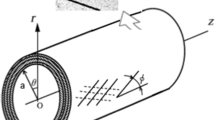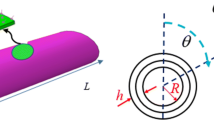Abstract
In this article, using analytical approach, the stress analysis of a long piezoelectric polymeric hollow cylinder reinforced with carbon nanotube (CNT) under combined magneto-thermo-electro-mechanical loading is investigated. Considering three combined loading conditions such as pressure-electric, pressure-electric magnetic and pressure-electric thermal, the governing equation of the problem is obtained. The rule of mixture and modified multiscale bridging model are used to predict effective properties of nanocomposite. The magneto-thermo-electro-mechanical stresses in hollow cylinder are discussed in detail. It can be concluded that increasing CNT volume fraction enhances strength of the nanocomposite cylinder. The results of this work could be useful in view of optimum design of the smart nanocomposite cylinder under magneto-thermo-electro-mechanical loadings and could also be as a reference for future related works.
Similar content being viewed by others
References
J. A. Mitchell and J. N. Reddy, A study of embedded piezoelectric layers in composite cylinders. Journal of Applied Mechanics, 62 (1995) 166–174.
X. Wang and K. Lu, Magneto thermodynamic stress and perturbation of magnetic field vector in a non-homogeneous thermoelastic cylinder, European Journal of Mechanics A/Solids, 25 (2006) 98–109.
H. J. Ding, H. M. Wang and P. F. Hou, The transient responses of piezoelectric hollow cylinders for axisymmetric plane strain problems, International Journal of Solids and Structures, 40 (2003) 105–123.
H. L. Dai and X. Wang, Magneto-thermo-electro-elastic transient response in a piezoelectric hollow cylinder subjected to complex loadings, International Journal of Solids and Structures, 43 (2006) 5628–5646.
P. F. Hou, H. J. Ding and A. Y. T. Leung, The transient responses of a special non-homogeneous magneto-electroelastic hollow cylinder for axisymmetric plane strain problem, Journal of Sound and Vibration, 291 (2006) 19–47.
A. Ghorbanpour Arani, R. Kolahchi and A. A. Mosallaie Barzoki, Effect of material in-homogeneity on electrothermo-mechanical behaviors of functionally graded piezoelectric rotating shaft. Applied Mathematical Modeling, 35 (2011) 2771–2789.
A. Ghorbanpour Arani, Sh. Maghamikia, M. Mohammadimehr and A. Arefmanesh, Buckling analysis of laminated composite rectangular plates reinforced by SWCNTs using analytical and finite element methods, Journal of Mechanical Science and Technology, 25(3) (2011) 809–820.
S. Yang and M. Cho, Scale bridging method to characterize mechanical properties of nanoparticle/polymer nanocomposites, Applied Physics Letters, 93(4) 043111 (2008) 1–3.
S. Yang and M. Cho, A scale-bridging method for nanoparticulate polymer nanocomposites and their non-dilute concentration effect, Applied Physics Letters, 94223104 (2009) 1–3.
S. Yu, S. Yang and M. Cho, Multi-scale modeling of cross-linked epoxy nanocomposites, Polymer, 50 (2009) 945–952.
S. Yu, S. Yang and M. Cho, Multiscale modeling of crosslinked epoxy nanocomposites to characterize the effect of particle size on thermal conductivity, Journal of Applied Physics, 110124302 (2011) 1–9.
S. Yang, S. Yu, W. Kyoung, D. S. Han and M. Cho, Multiscale modeling of size-dependent elastic properties of carbon nanotube/polymer nanocomposites with interfacial imperfections, Polymer, 53(2) (2012) 623–633.
S. Pill, Integration of Micromechanical and Probabilistic Analysis models of nanocomposites, The University of Toledo December, (2005).
P. Tan and L. Tong, Modeling of electro-magneto-thermoelastic properties of piezoelectric-magnetic fiber reinforced composites, Composites: Part A, 33 (2002) 631–645.
H. F. Tiersten, Linear piezoelectric plate vibrations, Plenum Press, New York, (1969).
Y. C. Fungn, Foundations of Solid Mechanics, Prentice-Hall, New York, (1965).
M. J. Khoshgoftar, A. Ghorbanpour and M. Arefi, Thermoelastic analysis of a thick walled cylinder made of functionally graded piezoelectric material, Smart Materials Structures, 18 (2009) 115007.
H. Rafii-Tabar, Computational modelling of thermomechanical and transport properties of carbon nanotubes. Physics Reports, 390 (2004) 235–452.
V. V. Kochervinski, Piezoelectricity in crystallizing ferroelectric polymers: Poly (vinylidene fluoride) and Its Copolymers (A Review), Crystallography Reports, 48 (2003) 649–675.
Author information
Authors and Affiliations
Corresponding author
Additional information
Recommended by Editor Maenghyo Cho
Ali Ghorbanpour Arani received his B.Sc. degree from Sharif University of Technology, Tehran, Iran, in 1988. He then received his M.Sc. degree from Amirkabir University of Technology, Tehran, Iran, in 1991 and his Ph.D degree from the Esfahan University of Technology, Esfahan, Iran, in 2001. Dr. Ali Ghorbanpour Arani is a Professor in the Mechanical Engineering Department of University of Kashan, Kashan, Iran. His current research interests are stress analyses, stability and vibration of nanotubes and functionally graded materials (FGMs).
Maedeh Rahnama Mobarakeh received her B.Sc. degree from Sharif University of Technology in Tehran, Iran, in 2006. She then received her M.Sc. degree from University of Kashan in Kashan, Iran, in 2010. Her research interests are stress analysis, nanomechanics and composite materials.
Shahrooz Shams received his B.Sc. degree from Isfahan University of Technology in Isfahan, Iran, in 2007. He then received his M.Sc. degree from University of Kashan in Kashan, Iran, in 2010. He is currently a Ph.D student at University of Kashan in Kashan, Iran. His research interests are continuum mechanics, nanomechanics, composites and functionally graded materials (FGMs); finite element and mesh free methods.
Mehdi Mohammadimehr received his B.Sc. degree from the University of Kashan in Kashan, Iran, in 2002. He then received his M.Sc and Ph.D degrees from Shahid Bahonar University of Kerman in Kerman, Iran, in 2004 and 22 May 2010. Dr. Mehdi Mohammadimehr is currently an Assistant Professor in Mechanical Engineering Department of University of Kashan in Kashan, Iran. His research interests include elasticity, plasticity, continuum mechanics, nanomechanics, composite materials, functionally graded materials (FGMs), beams, plates and shells theories, buckling, postbuckling and vibration analyses of carbon nanotubes (CNTs), and finite element method (FEM).
Rights and permissions
About this article
Cite this article
Arani, A.G., Mobarakeh, M.R., Shams, S. et al. The effect of CNT volume fraction on the magneto-thermo-electro-mechanical behavior of smart nanocomposite cylinder. J Mech Sci Technol 26, 2565–2572 (2012). https://doi.org/10.1007/s12206-012-0639-5
Received:
Revised:
Accepted:
Published:
Issue Date:
DOI: https://doi.org/10.1007/s12206-012-0639-5




